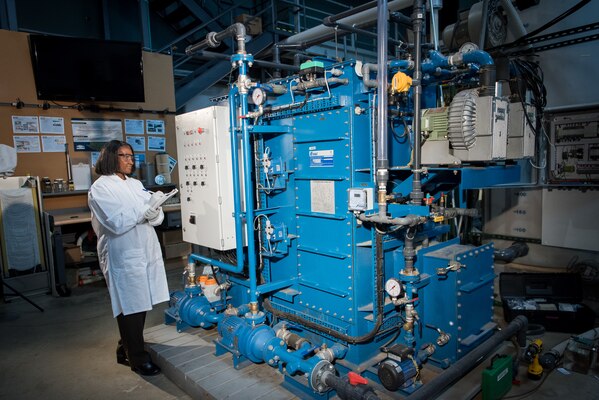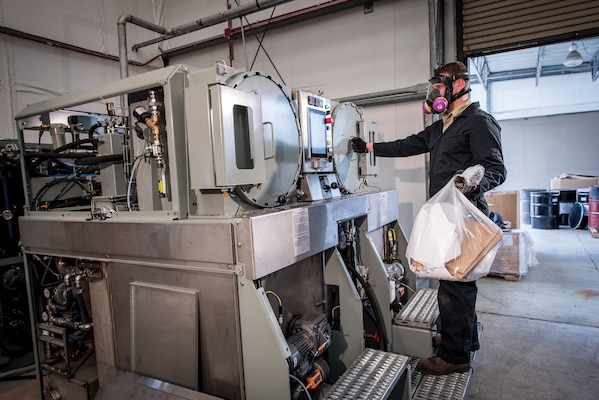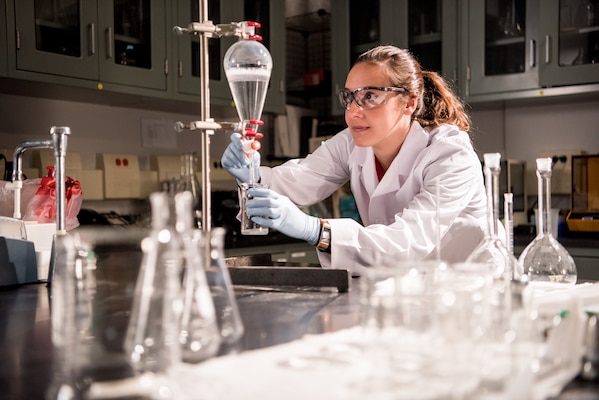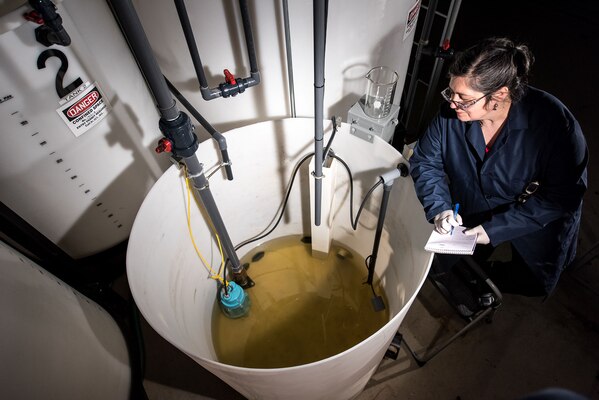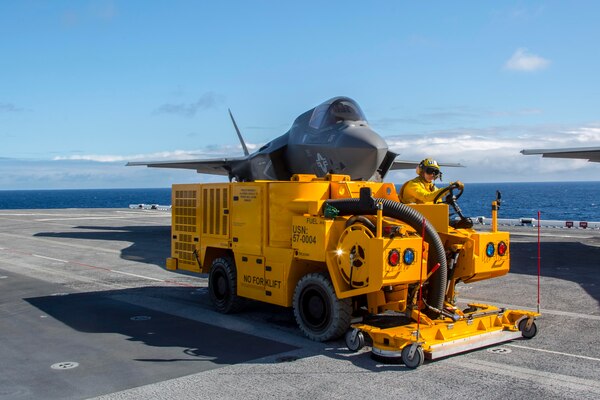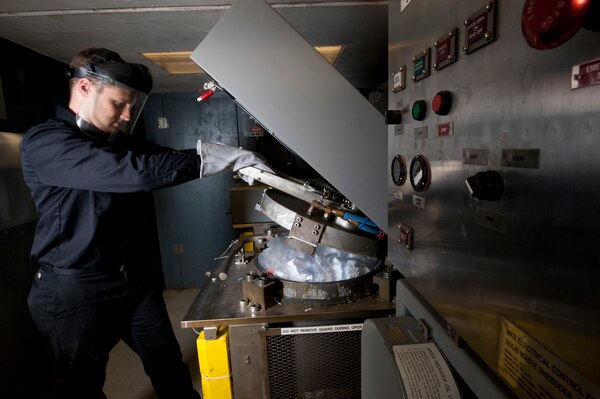Carderock Engineers Lead Environmental Research, Development, Testing and Evaluation
Published on by Water Network Research, Official research team of The Water Network in Government
Sheila Riggs analyzes data from the Membrane Bio Reactor, which treats blackwater and graywater to be ready for discharge from a ship on May 10, 2017, at Naval Surface Warfare Center, Carderock Division in West Bethesda, Md. Riggs is part of the Environmental Engineering, Science, and Technology Branch’s Non-oily Wastewater Team that is working on testing vendor’s treatment system. (Photo by Jake Cirksena)
Peter Mech, an engineer with Naval Surface Warfare Center, Carderock Division’s Environmental Engineering, Science, and Technology Branch, loads the Micro-Auto Gasification System (MAGS) incinerator to thermally destroy solid waste on May 10, 2017. Mech is part of the Solid Waste Program at Carderock in West Bethesda, Md., where they research better ways to help Sailors on ships and submarines manage solid waste. (Photo by Jake Cirksena)
Danielle Paynter, part of the Oil Pollution Abatement Team in the Environmental Engineering, Science, and Technology Branch, researches emulsions in the lab at Naval Surface Warfare Center, Carderock Division on May 10, 2017, in West Bethesda, Md. (Photo by Jake Cirksena)
Rachel Jacobs, a chemical engineer with Naval Surface Warfare Center, Carderock Division’s Environmental Engineering, Science, and Technology Branch, analyzes water in a tank in the Ballast Water Treatment Lab at Carderock’s West Bethesda, Md. Site on May 10, 2017. (Photo by Jake Cirksena)
A Sailor operates the Mobile Cleaning, Recovery, and Recycling System (MCRRS) on the flight deck of USS America (LHA 6) on Nov. 1, 2016. The MCRRS, which was developed by Naval Surface Warfare Center, Carderock Division’s Ship-to-Shore Team within the Environmental Engineering, Science, and Technology Branch, is a heavy-duty, self-powered cleaning vehicle that removes solid and liquid foreign0object debris from flight decks and other nonskid surfaces using water-jet technology with rapid-air movement. (Photo by Darin Russell)
Peter Mech, an engineer with Naval Surface Warfare Center, Carderock Division’s Environmental Engineering, Science, and Technology Branch, operates the Plastic Waste Processor on July 23, 2015. Mech is part of the Solid Waste Program at Carderock in West Bethesda, Md., where they research better ways to help Sailors on ships and submarines manage solid waste. (Photo by Devin Pisner)
Naval Surface Warfare Center, Carderock Division is home to many unique facilities, but few are like the environmental laboratories managed by the Environmental Engineering, Science and Technology Branch (Code 633). Between the Building 60 Solid Waste, Wastewater, Ballast and Analytical Laboratories, and the Building 63 Thermal Destruction Laboratory, Code 633 engineers, scientists and technicians combine their expertise across multiple technical areas to design environmental treatment and management solutions for the U.S. Navy, DoD and other agencies.
A deep and diverse knowledge base allows Code 633 to find solutions and swiftly determine missing information when a sponsor approaches NSWCCD with environmental issues. For example, one of the most common issues Carderock engineers encounter is the lack of understanding the shipboard waste composition before being asked to propose a feasible treatment or management practice. “Often, our customers will come up to us with a particular problem, but they do not know for sure the make‐up or specific constituents of the waste they need treated or managed,” Branch Head Steve Verosto (Code 633) said. “We want to fully characterize the material so we can simulate it in our lab and create a realistic solution that will work in the field. We frequently begin by trying to establish a baseline of the customer’s foundational functional requirements with them.”
Ballast water is a growth area for Code 633, and one with some of the most significant ecological impacts. While the manipulation of incoming ballast water is crucial as a stability mechanism to adjust the draft, list and trim of all modern seagoing vessels, aquatic organisms brought onboard (and then later discharged) with the ballast water can pose a serious threat to marine ecosystems. If those transported species should become aquatic nuisance species (ANS), the new environment may lack natural predators to control their population. Zebra mussels are a classic case of ANS that invaded North American lakes including Lake Erie and Lake Michigan by reaching these waters through ships’ ballast water tanks. “The Zebra mussels are probably the most famous of all the non‐indigenous species that invaded the Great Lakes in the 1980s,” Verosto said. “They caused billions of dollars in infrastructure damage and loss of critical ecosystems there. The real concern is that if these organisms are discharged into a new environment they may survive – and survive well – by killing off other aspects of the ecosystem.” Code 633’s ballast group is responsible for conducting research to prevent Navy ships and other vessels from being potential vectors for ANS. They investigate available commercial ballast water treatment technologies, determine methodologies to adapt such technologies to marine vessels, test full‐scale systems suitable to the Navy and other customers, recommend options to forward‐fit vessels, and engage in research and development for tools and technologies that bridge the gap between available equipment and customer needs.
Code 633 is also intimately involved with the development of Uniform National Discharge Standards (UNDS). UNDS is a partnership between the Department of Defense and the Environmental Protection Agency (EPA), in accordance with the National Defense Authorization Act of 1996, to identify and evaluate discharges of Armed Forces vessels to determine which discharges require control for protection of the environment and to set uniform standards for those discharges to enhance operational flexibility. The objective of UNDS is to enhance the development of innovative pollution control practices and technologies for discharges from Armed Forces vessels, using environmentally sound operations while accomplishing the military mission. Currently, there are 39 discharges that have been identified that are generated by Armed Forces vessels, of which 25 need to be controlled, including ballast water, seawater cooling overboard discharge, gas turbine water wash, graywater, bilgewater and underwater ship husbandry. To help make recommendations for UNDS standards and develop methodologies for UNDS implementation, Code 633 engineers collaborate with subject matter experts across the Armed Forces to establish reasonable and practicable best management and equipment controls based on vessel operations, applicable laws and standards, environmental effects and cost.
Down the hall from the ballast laboratory, teams working in Code 633’s Solid Waste Program dedicate themselves on multiple fronts to solve a different variety of shipboard challenges. In one laboratory, experimental compactors are tested for Sailors to use on submarines while Compress Melt Units (CMU) reduce the volume of shipboard‐generated plastics. Other compactors have been tested for large aluminum cans, cardboard and mixed waste. In the building next door, the team tests large incineration capabilities for surface ships. The team has recently conducted laboratory testing of the Micro Auto Gasification System (MAGS) V8, an incinerator that processes waste at 30‐70 pounds per hour and a large incinerator that processes at 200‐250 pounds per hour, to ideally reduce all combustible shipboard waste streams by 95%. They have also been testing a new ash vacuum system to move the ash from incinerators to storage containers. Such waste processing would result in major cost savings to the Fleet by significantly reducing offloading and pierside treatment costs. The solid waste team is also the In‐Service Engineering Agent (as of June 2020) for the Plasma Arc Waste Destruction System (PAWDS) installed aboard the CVN 78 Class. The PAWDS was developed by Code 633 and processes mixed solid waste at a rate of 450 pounds per hour. Finally, the team also performs waste generation rate, waste processing, and waste storage analyses to support the planning of waste handling aboard ships.
Another cost‐saving device that was developed by the Code 633 Ship to Shore (S2S) Team is the Shipboard Mobile Cleaning, Recovery and Recycling System (MCRRS). The MCRRS is a heavy‐duty, self-powered cleaning vehicle that removes solid and liquid foreign object debris (FOD) from flight decks and other nonskid surfaces using water jet technology with rapid air movement. The technology replaces Sailor SCRUB‐X, which uses soap and hundreds of Sailors, and also replaces the obsolete, ineffective shipboard mechanical scrubbers. The MCRRS removes and captures debris while recycling potable water as the cleaning fluid. NSWCCD Code 633 played a key role in the design and implementation of the MCRRS technology and continues to support NAVSEA as the primary subject-matter experts and key fleet-transition and support agent.
These responsibilities include accepting vehicles from the OEM, training Sailors, providing demand signal support to deployed forces aboard ship, developing and implementing necessary design adjustments for equipment modernization, and performing initial ISEA and sustainment functions. The MCRRS is recognized by CNO as a required materiel solution for achieving flight deck readiness and is being deployed to all Big Deck Amphibious Ships and Carriers to reduce aircraft engine damage from FOD and mishaps related to inadequate coefficient of friction on surfaces. Benefits include increased flight deck readiness and weapon systems availability, savings in overall cost and increased Sailor safety and availability. The S2S team also performs an array of other investigatory research, novel equipment development, process improvement, and direct Fleet intervention efforts to increase Fleet and support entity capabilities, productivity, cost savings and environmental performance on ships, pier‐side, at shipyards in dry‐docks, and at other Navy mission support facilities.
Back in Building 60, an Oily and a Non‐oily Wastewater Team work in parallel within a large, industrial wastewater laboratory. The Non‐oily team is currently working on testing a vendor’s combined graywater/blackwater treatment system while consulting on how to test a shipboard Vacuum Collection, Holding and Transfer (VCHT) system improvement. The VCHT system gage lines are being clogged with sewage, causing performance issues with the ejector pumps and making them start and stop erratically.
The excessive cycling of the pump then leads to increased wear, time‐consuming maintenance and critical system downtime. The team is in the process of determining whether the installation of in‐line cylindrical diaphragm isolators coupled with integrated pressure instrumentation are suitable for the legacy systems.
Taxonomy
- Research
- Ballast Water
2 Comments
-
I really appreciate the above. Knowledge sharing/partnerships are the key to manage solutions/innovations to environment challenges +pollution free Africa/planet.
-
One can understate the rational of wanting to fully characterising the material in other to simulate it in lab instead strangle in the field, that would have been extremely to create a realistic solution that could have worked in the field. Fantastic solution.
